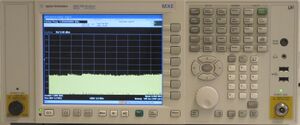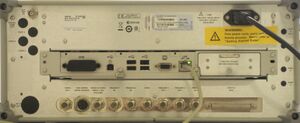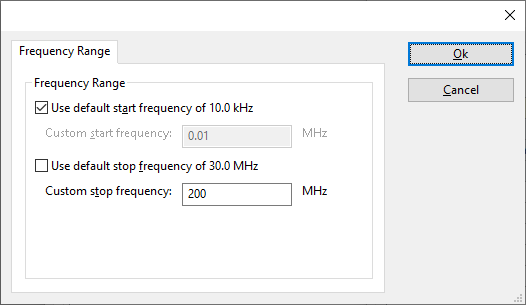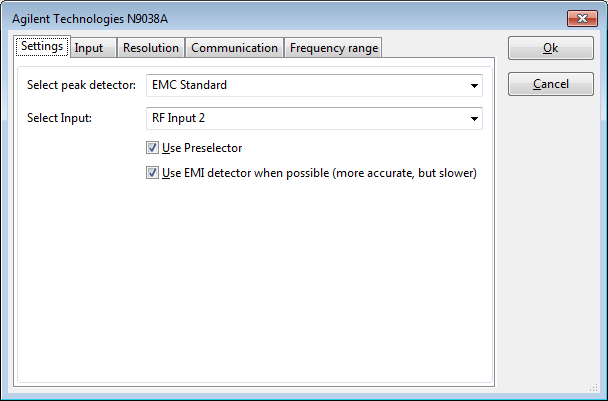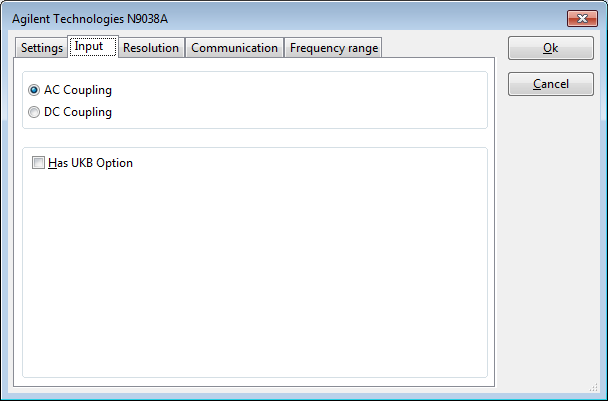Agilent Technologies N9038A: Difference between revisions
DevicesBot (talk | contribs) (Updated DeviceDriverInfo template) |
DevicesBot (talk | contribs) (Updated DeviceDriverInfo template) |
||
| Line 2: | Line 2: | ||
|DLLFile=RADHPSA.DLL | |DLLFile=RADHPSA.DLL | ||
|DeviceBrand=Agilent Technologies | |DeviceBrand=Agilent Technologies | ||
|DeviceDriverName= | |DeviceDriverName=AGILENTN9038A | ||
|DeviceType=N9038A | |DeviceType=N9038A | ||
|HideAutoData=1 | |HideAutoData=1 | ||
|SupportedDeviceTypes= | |SupportedDeviceTypes=512 | ||
}} | }} | ||
Revision as of 10:26, 4 March 2020
The Agilent Technologies N9038A device driver is a Spectrum Analyser which is supported by RadiMation®.
Configuration[edit]
The following tabs are available in the advanced configuration of the Agilent Technologies N9038A:
The frequency range of the Agilent Technologies N9038A as provided by the manufacturer is shown and selected as default. It is possible to overrule these frequencies and to manual adjust the allowed frequency range of the Agilent Technologies N9038A.
| If the checkbox is checked, the default start frequency will be used as the lowest usable frequency in a test for this device. |
| If the Use default start frequency checkbox is unchecked, another start frequency (expressed in MHz) can be specified. The customized start frequency will then be used as the lowest usable frequency in a test for this device. The customized frequency can be a limitation or an extension of the default start frequency. |
| If the checkbox is checked, the default stop frequency will be used as the highest usable frequency in a test for this device. |
| If the Use default stop frequency checkbox is unchecked, another stop frequency (expressed in MHz) can be specified. The customized stop frequency will then be used as the highest usable frequency in a test for this device. The customized frequency can be a limitation or an extension of the default stop frequency. |
Specifying a different frequency range can be useful if for example:
- A device (like a coupler, antenna, injection device, cable, etc...) is still useable (but out of specification) outside the standard suggested frequency range.
- An external mixer is used to measure an extended frequency range.
- An up- or down-convertor is used to shift the frequency range.
- A newer model of a device is present that has an extended frequency range, and still uses the same remote control commands.
Be careful changing these setting as RadiMation® is no longer able to verify if the Agilent Technologies N9038A is used outside frequency range that is specified by the manufacturer. This may result to serious damage of your measurement device.
The 'Advanced' configuration dialog of the Agilent Technologies N9038A device driver has several tabs to configure the device driver.
Settings[edit]
| Specifies the standard that should be used for the peak detector. Possible standards are: 'EMC Standard' or 'MIL Standard'. |
| Specifies the input that should be used. Depending the exact model used, it is possible that the selection of the input is disabled. |
| If the preselector should be enabled or not. |
| Specifies if the EMI average or non-EMI average detector should be used. The EMI average detector is more accurate, but also slower than the non-EMI average detector. Depending on the available options in the measurement device it is possible to select the EMI average detector. When this option is activated and the EMI average detector is available, the EMI average detector will be selected. Otherwise the non-EMI average detector will be selected. |
Input[edit]
| Specifies if AC or DC couling of the input should be selected. |
| Specifies if the UKB option is present in the device, which will allow to perform measurements on a lower frequency range. |
